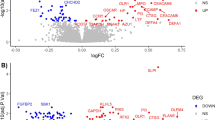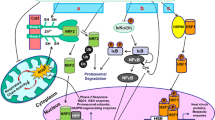Abstract
Little is known about the biological mechanisms underpinning the pathology of schizophrenia. We have analysed the proteome of stimulated and unstimulated peripheral blood mononuclear cells (PBMCs) from schizophrenia patients and controls as a potential model of altered cellular signaling using liquid-chromatography mass spectrometry proteomic profiling. PBMCs from patients and controls were stimulated for 72 h in vitro using staphylococcal enterotoxin B. In total, 18 differentially expressed proteins between first-onset, antipsychotic-naive patients and controls in the unstimulated and stimulated conditions were identified. Remarkably, eight of these proteins were associated with the glycolytic pathway and patient–control differences were more prominent in stimulated compared with unstimulated PBMCs. None of these proteins were altered in chronically ill antipsychotic-treated patients. Non-linear multivariate statistical analysis showed that small subsets of these proteins could be used as a signal for distinguishing first-onset patients from controls with high precision. Functional analysis of PBMCs did not reveal any difference in the glycolytic rate between patients and controls despite increased levels of lactate and the glucose transporter-1, and decreased levels of the insulin receptor in patients. In addition, subjects showed increased serum levels of insulin, consistent with the idea that some schizophrenia patients are insulin resistant. These results show that schizophrenia patients respond differently to PBMC activation and this is manifested at disease onset and may be modulated by antipsychotic treatment. The glycolytic protein signature associated with this effect could therefore be of diagnostic and prognostic value. Moreover, these results highlight the importance of using cells for functional discovery and show that it may not be sufficient to measure protein expression levels in static states.
This is a preview of subscription content, access via your institution
Access options
Subscribe to this journal
Receive 12 print issues and online access
$259.00 per year
only $21.58 per issue
Buy this article
- Purchase on Springer Link
- Instant access to full article PDF
Prices may be subject to local taxes which are calculated during checkout



Similar content being viewed by others
References
Pack S . Poor physical health and mortality in patients with schizophrenia. Nurs Stand 2009; 23: 41–45.
Sawa A, Snyder SH . Schizophrenia: diverse approaches to a complex disease. Science 2002; 296: 692–695.
Riley B, Kendler KS . Molecular genetic studies of schizophrenia. Eur J Hum Genet 2006; 14: 669–680.
Rutter M, Moffitt TE, Caspi A . Gene–environment interplay and psychopathology: multiple varieties but real effects. J Child Psychol Psychiatry 2006; 47: 226–261.
Martins-de-Souza D, Gattaz W, Schmitt A, Rewerts C, Maccarrone G, Dias-Neto E et al. Prefrontal cortex shotgun proteome analysis reveals altered calcium homeostasis and immune system imbalance in schizophrenia. Eur Arch Psychiatry Clin Neurosci 2009; 259: 151–163.
Harris L, Swatton J, Wengenroth M, Wayland M, Lockstone H, Holland A et al. Differences in protein profiles in schizophrenia prefrontal cortex compared to other major brain disorders. Clin Schizophrenia Relat Psychoses 2007; 1: 73–91.
Meyer JM, Stahl SM . The metabolic syndrome and schizophrenia. Acta Psychiatrica Scandinavica 2009; 119: 4–14.
Guest PC, Wang L, Harris LW, Burling K, Levin Y, Ernst A et al. Increased levels of circulating insulin-related peptides in first-onset, antipsychotic naive schizophrenia patients. Mol Psychiatry 2010; 15: 118–119.
Riedel M, Spellmann I, Schwarz MJ, Strassnig M, Sikorski C, Moller HJ et al. Decreased T cellular immune response in schizophrenic patients. J Psychiatr Res 2007; 41: 3–7.
Herberth M, Krzyszton DN, Koethe D, Craddock MR, Bulger E, Schwarz E et al. Differential effects on T-cell function following exposure to serum from schizophrenia smokers. Mol Psychiatry 2010; 15: 364–371.
Craddock RM, Huang JT, Jackson E, Harris N, Torrey EF, Herberth M et al. Increased alpha-defensins as a blood marker for schizophrenia susceptibility. Mol Cell Proteomics 2008; 7: 1204–1213.
Kuzman MR, Medved V, Terzic J, Krainc D . Genome-wide expression analysis of peripheral blood identifies candidate biomarkers for schizophrenia. J Psychiatr Res 2009; 43: 1073–1077.
Torres KCL, Souza BR, Miranda DM, Nicolato R, Neves FS, Barros AGA et al. The leukocytes expressing DARPP-32 are reduced in patients with schizophrenia and bipolar disorder. Progress Neuropsychopharmacol Biol Psychiatry 2009; 33: 214–219.
Rollins B, Martin MV, Morgan L, Vawter MP . Analysis of whole genome biomarker expression in blood and brain. Am J Med Genet B Neuropsychiatr Genet 2010; 153B: 919–936.
Fox CJ, Hammerman PS, Thompson CB . Fuel feeds function: energy metabolism and the T-cell response. Nat Rev Immunol 2005; 5: 844–852.
Craddock RM, Lockstone HE, Rider DA, Wayland MT, Harris LJ, McKenna PJ et al. Altered T-cell function in schizophrenia: a cellular model to investigate molecular disease mechanisms. PLoS ONE 2007; 2: e692.
Levin Y, Schwarz E, Wang L, Leweke FM, Bahn S . Label-free LC-MS/MS quantitative proteomics for large-scale biomarker discovery in complex samples. J Sep Sci 2007; 30: 2198–2203.
Schwarz E, Levin Y, Wang L, Leweke FM, Bahn S . Peptide correlation: a means to identify high quality quantitative information in large-scale proteomic studies. J Sep Sci 2007; 30: 2190–2197.
Liu X-Y, Yang J-L, Chen L-J, Zhang Y, Yang M-L, Wu Y-Y et al. Comparative proteomics and correlated signaling network of rat hippocampus in the pilocarpine model of temporal lobe epilepsy. Proteomics 2008; 8: 582–603.
Cheng TM, Lu YE, Guest PC, Rahmoune H, Harris LW, Wang L et al. Identification of targeted analyte clusters for studies of schizophrenia. Mol Cell Proteomics 2010; 9: 510–522.
Schoelkopf B, Smola A, Mueller K-R . Nonlinear component analysis as a kernel eigenvalue problem. Neural Comput 1998; 10: 1299–1319.
Libby P . Role of inflammation in atherosclerosis associated with rheumatoid arthritis. Am J Med 2008; 121 (10, Supplement 1): S21–S31.
Davies AMC, Fearn T . Back to basics: the principles of principal component analysis. Spectrosc Eur 2005; 4: 20–23.
Roos D, Loos JA . Changes in the carbohydrate metabolism of mitogenicellay stimulated human peripheral lymphocytes I. Stimulation by phytohaemagglutinin. Biochim Biophys Acta 1970; 222: 565–582.
Wu C, Khan SA, Lange AJ . Regulation of glycolysis—role of insulin. Exp Gerontol 2005; 40: 894–899.
Frauwirth KA, Riley JL, Harris MH, Parry RV, Rathmell JC, Plas DR et al. The CD28 signaling pathway regulates glucose metabolism. Immunity 2002; 16: 769–777.
Frauwirth KA, Thompson CB . Regulation of T lymphocyte metabolism. J Immunol 2004; 172: 4661–4665.
Jin EH, Shim SC, Kim HG, Chae SC, Chung HT . Polymorphisms of COTL1 gene identified by proteomic approach and their association with autoimmune disorders. Exp Mol Med 2009; 41: 354–361.
Dai H, Huang W, Xu J, Yao B, Xiong S, Ding H et al. Binding model of human coactosin-like protein with filament actin revealed by mutagenesis. Biochim Biophys Acta 2006; 1764: 1688–1700.
Martins-de-Souza D, Gattaz W, Schmitt A, Novello J, Marangoni S, Turck C et al. Proteome analysis of schizophrenia patients Wernicke's area reveals an energy metabolism dysregulation. BMC Psychiatry 2009; 9: 17.
Martins-de-Souza D, Gattaz WF, Schmitt A, Maccarrone G, Hunyadi-Gulyas E, Eberlin MN et al. Proteomic analysis of dorsolateral prefrontal cortex indicates the involvement of cytoskeleton, oligodendrocyte, energy metabolism and new potential markers in schizophrenia. J Psychiatr Res 2009; 43: 978–986.
Kim JJ, Mandelli L, Lim S, Lim HK, Kwon OJ, Pae CU et al. Association analysis of heat shock protein 70 gene polymorphisms in schizophrenia. Eur Arch Psychiatry Clin Neurosci 2008; 258: 239–244.
Arion D, Unger T, Lewis DA, Levitt P, Mirnics K . Molecular evidence for increased expression of genes related to immune and chaperone function in the prefrontal cortex in schizophrenia. Biol Psychiatry 2007; 62: 711–721.
Chiu HY, Tsao LY, Yang RC . Heat-shock response protects peripheral blood mononuclear cells (PBMCs) from hydrogen peroxide-induced mitochondrial disturbance. Cell Stress Chaperones 2009; 14: 207–217.
MacIver NJ, Jacobs SR, Wieman HL, Wofford JA, Coloff JL, Rathmell JC . Glucose metabolism in lymphocytes is a regulated process with significant effects on immune cell function and survival. J Leukoc Biol 2008; 84: 949–957.
Taguchi A, Wartschow LM, White MF . Brain IRS2 signaling coordinates life span and nutrient homeostasis. Science 2007; 317: 369–372.
Convit A . Links between cognitive impairment in insulin resistance: an explanatory model. Neurobiol Aging 2005; 26 (Suppl 1): 31–35.
Craft S . Insulin resistance and Alzheimer's disease pathogenesis: potential mechanisms and implications for treatment. Curr Alzheimer Res 2007; 4: 147–152.
Prabakaran S, Swatton JE, Ryan MM, Huffaker SJ, Huang JT, Griffin JL et al. Mitochondrial dysfunction in schizophrenia: evidence for compromised brain metabolism and oxidative stress. Mol Psychiatry 2004; 9: 684–697, 643.
Liu Z, Zhang YW, Chang YS, Fang FD . The role of cytoskeleton in glucose regulation. Biochemistry (Mosc) 2006; 71: 476–480.
Magistretti PJ . Neuron–glia metabolic coupling and plasticity. J Exp Biol 2006; 209 (Part 12): 2304–2311.
Salim K, Guest PC, Skynner HA, Bilsland JG, Bonnert TP, McAllister G et al. Identification of proteomic changes during differentiation of adult mouse subventricular zone progenitor cells. Stem Cells Dev 2007; 16: 143–165.
Stone SW, Faraone SV, Su J, Tarbox SI, Van Eerdewegh P, Tsuang MT . Evidence for linkage between regulatory enzymes in glycolysis and schizophrenia in a multiplex sample. Am J Med Genet B Neuropsychiatr Genet 2004; 127B: 5–10.
Dwyer DS, Bradley RJ, Kablinger AS, Freeman III AM . Glucose metabolism in relation to schizophrenia and antipsychotic drug treatment. Ann Clin Psychiatry 2001; 13: 103–113.
Zabel C, Andreew A, Mao L, Hartl D . Protein expression overlap: more important than which proteins change in expression? Expert Rev Proteomics 2008; 5: 187–205.
Pancholi V . Multifunctional alpha-enolase: its role in diseases. Cell Mol Life Sci 2001; 58: 902–920.
Müller N, Schwarz MJ . [Immunology in schizophrenic disorders]. Nervenarzt 2007; 78: 253–256, 258–260, 262–263.
Acknowledgements
We thank all volunteer patients and control blood donors. We also thank all members of the Bahn laboratory for helpful discussions. We especially thank Keith Burling from NIHR Cambridge Biomedical Research Centre, Core Biochemistry Assay Laboratory, Addenbrooke's Hospital for performing the insulin/glucose assays. This research was supported by Stanley Medical Research Institute (SMRI). MH was supported by the Cambridge European Trust.
Author information
Authors and Affiliations
Corresponding author
Ethics declarations
Competing interests
The authors declare no conflict of interest.
Additional information
Supplementary Information accompanies the paper on the Molecular Psychiatry website
Rights and permissions
About this article
Cite this article
Herberth, M., Koethe, D., Cheng, T. et al. Impaired glycolytic response in peripheral blood mononuclear cells of first-onset antipsychotic-naive schizophrenia patients. Mol Psychiatry 16, 848–859 (2011). https://doi.org/10.1038/mp.2010.71
Received:
Revised:
Accepted:
Published:
Issue Date:
DOI: https://doi.org/10.1038/mp.2010.71
Keywords
This article is cited by
-
Targeted metabolomics reveals aberrant profiles of serum bile acids in patients with schizophrenia
Schizophrenia (2022)
-
Diagnostic model development for schizophrenia based on peripheral blood mononuclear cell subtype-specific expression of metabolic markers
Translational Psychiatry (2022)
-
Functional patient-derived cellular models for neuropsychiatric drug discovery
Translational Psychiatry (2021)
-
Novel standardized method for extracellular flux analysis of oxidative and glycolytic metabolism in peripheral blood mononuclear cells
Scientific Reports (2021)
-
The Potential Use of Peripheral Blood Mononuclear Cells as Biomarkers for Treatment Response and Outcome Prediction in Psychiatry: A Systematic Review
Molecular Diagnosis & Therapy (2021)



